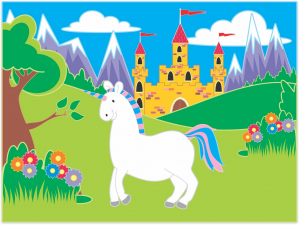
Magical thinking. It’s everywhere. And in no place or time is it more powerful than in childhood.
‘Childhood,’ wrote Edna St Vincent Millay, “is the kingdom where nobody dies.”
As a child, I was quite certain that I wasn’t going to die. A space ship, or a time traveller, would turn up at some point in my adulthood and I would be spared; whisked away to another universe. I absolutely knew this was true. For years. Childhood is not necessarily the kingdom where nobody dies, but it is the kingdom where everything is possible. Where your toys come alive when you’re not there. Where there are monsters in your wardrobe or under your bed. Where if you swallow an apple pip, a tree might grow inside you. Where if you tried hard enough, you could move things with your mind. Where if you can’t see something, it doesn’t exist. Where you definitely don’t believe in ghosts but you hope they wont haunt you for not believing in them. Where mirrors are windows to other worlds. Where there might actually, really be a unicorn living in the woods. Where there is a gender fairy who pops pink or blue brains into our bodies at birth, and a girl can turn into a boy if she really, really wants to and wishes for it hard enough.
Children are experts in magical thinking. While they learn at an incredible rate, they haven’t been around very long so they only have a small frame of reference. Kids haven’t yet developed very accurate tools for differentiating between fantasy and reality. Can a child possibly understand the physical and psychological input involved with developing and maintaining a trans identity? Can a child really give informed consent to transition?
Gender identity problems in children are not new, but they have increased exponentially in the last decade. Traditionally 80% or more of children who believed themselves to be ‘born in the wrong body’ desisted by the end of puberty.
In 2009, the Endocrine society observed “Given the high rate of remission of GID after the onset of puberty, we recommend against a complete social role change and hormone treatment in prepubertal children with GID.”
‘Watchful waiting’ was considered to be best practice and nobody was rushing to affirm and consolidate any sort of identity in a child barely old enough to have become aware of the concept.
“Trans activists warn focusing too heavily on desistance encourages people to take gender dysphoria in children less seriously,” writes LGBTQ reporter Ana Valens in The Daily Dot.
HOW Many Trans Kids?
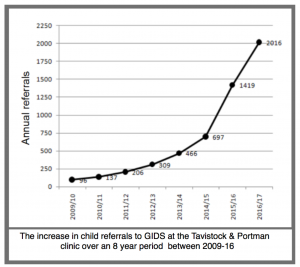 GIDS (Gender Identity Development Service), which treats children under 18 in the UK, received 94 referrals of children in 2009/10. By 2016/17 this had risen to 1,986 referrals. (figures adjusted to removed 18+)
GIDS (Gender Identity Development Service), which treats children under 18 in the UK, received 94 referrals of children in 2009/10. By 2016/17 this had risen to 1,986 referrals. (figures adjusted to removed 18+)
That’s not two, not ten, but TWENTY TIMES as many children referred in the space of a decade.
In Australia, Melbourne’s Royal Children’s Hospital is struggling to cope with demand for child gender services. From one patient in 2003, the hospital expects to see 200 children and adolescents this year.
Activists say this is because historically children have not ‘had the words’ to explain being transgender and, due to increased publicity about the condition, more kids are coming forward. They say the children that desisted in those studies desisted because they were misdiagnosed or ‘not real trans’. Others claim that there was no follow up on many of the children, but this has been shown to be untrue.
It seems hard to equate those views. There were less children coming forward a decade ago, but they were mostly misdiagnosed? Now there are twenty times as many children coming forward but they are not being misdiagnosed? It just doesn’t seem to add up.
One thing most people would agree on is that as awareness has increased, the notion of the transgender child has captured the imagination of the press, parents and gender non-conforming children everywhere.
With the advent of the ‘tranzkidz’, traditional approaches have changed. Nobody seems interested in asking where all these transgender children have sprung from. Instead, numerous articles online and in newspapers and magazines chart the story of the girls who live as boys and the boys who live as girls. Transition is a life or death matter, we are all told, despite there being little or no evidence to support this.
Stereotypes & Sexism
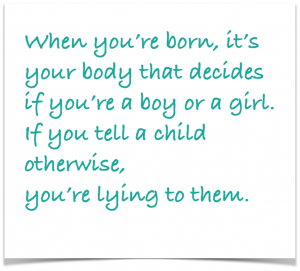 The sexism of the ‘born in the wrong body’ myth is gargantuan and usually entirely overlooked. That’s the fundamental premise behind the transgender child. It seems to be less about breaking down stereotypes and freeing the spirit and more about those good old-fashioned, sexist, pink and blue boxes; selling the illusion of how elementary and desirable it might be to skip between the two to children too young to know any better. The majority of the mainstream press has bought into this idea. Journalists like Janice Turner, Andrew Gilligan and Jesse Singal, who have dared to question the current trans-narrative are called ‘transphobic’ and accused of stiring up hatred against trans people.
The sexism of the ‘born in the wrong body’ myth is gargantuan and usually entirely overlooked. That’s the fundamental premise behind the transgender child. It seems to be less about breaking down stereotypes and freeing the spirit and more about those good old-fashioned, sexist, pink and blue boxes; selling the illusion of how elementary and desirable it might be to skip between the two to children too young to know any better. The majority of the mainstream press has bought into this idea. Journalists like Janice Turner, Andrew Gilligan and Jesse Singal, who have dared to question the current trans-narrative are called ‘transphobic’ and accused of stiring up hatred against trans people.
If we tell a child that Jack is a girl born in a boy’s body, what is the child supposed to understand by that? What does that tell the child about sexism and stereotyping?
In the words of one young person on YouTube: “My whole childhood was just basically like, you’re a boy, you can’t play with that, you’re a boy you can’t do that, you’re a boy, ner ner ner… & every night I’d go to bed and be like, ‘God, why don’t they understand that I’m not a boy?'”
WHY couldn’t he play with that? WHY couldn’t he do that? WHY aren’t we addressing the unjust and ingrained sexism in society rather than medicating & reforming young people’s minds and bodies to fit new stereotypes?
A young Australian transgender child’s parents report that she wakes up in the night with screams of,“Change my clothes, change my clothes!” For Pete’s sake, change the child’s clothes! Let her wear what she likes!
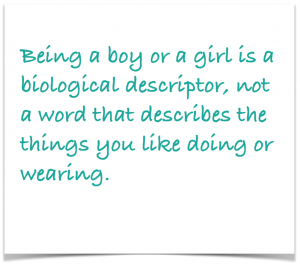 We need to tell children that there is no right or wrong way to be a boy or a girl and that they shouldn’t be defined by their genitals. You don’t get to decide if you’re born a boy or a girl, and it should not affect the games you play, the clothes you wear or the choices you make. Telling kids that girls’ brains are one way and boys’ brains are another way is sexist. We know it to be untrue.
We need to tell children that there is no right or wrong way to be a boy or a girl and that they shouldn’t be defined by their genitals. You don’t get to decide if you’re born a boy or a girl, and it should not affect the games you play, the clothes you wear or the choices you make. Telling kids that girls’ brains are one way and boys’ brains are another way is sexist. We know it to be untrue.
A great number of the human rights battles of the last century were fought in the name of equality between the sexes, and those battles should not be erased with a swish of the gender fairy’s wand. Being a boy or a girl is a biological descriptor, not a word that describes the things you like doing or wearing. Boys and girls are biologically different, but that doesn’t mean they have pink and blue brains, or need to behave in certain ways.
On the subject of stereotypes, this is what Jazz Jennings, famous child reality show star, has to say in ‘I am Jazz‘: “For as long as I can remember, my favorite color has been pink… most of all I love mermaids.”
What seeds does this sow in the minds of children? Certainly not the idea that kids are perfect as they are. What does it mean to the girl who likes football, to the boy who likes pink tutus? To the child that ‘doesn’t do girl right’ or to the effeminate boy? The child who already feels different to their peers may see this as a way to fit in, and a way to be special all rolled into one. If we can’t explain how a child can be transgender without recourse to stereotypes and sexist generalisations, then how can we expect a child to think there is more to it than that?
Take away the stereotypes and we are left with, ‘some kids ‘just know‘. Like I knew I was invincible? Like my five year old brother-in-law knew he could learn to fly? How about if the adults around us had been telling us yes, we were different to other kids and those beliefs were correct?
When you’re born, it’s your body that makes you a boy or a girl. If you tell a child otherwise, you are lying to them. We don’t get to choose. We just are.
Informed consent is not informed if it’s based on a lie.
How young is too young?
Diane Ehrensaft infamously claimed that trans babies might pull out their hairslides or make dresses of their babygros. Of course, females are not genetically pre-programmed to like things stuck in our hair, and wearing floaty robes is considered the norm for men in many parts of the world. Stereotypes yet again.
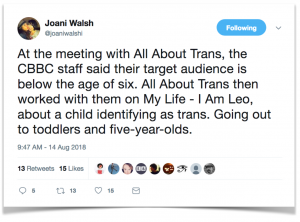
‘All About Trans’ is an organisation set up to improve portrayal of trans people in the media.
After meetings with AAT, CBBC (the children’s branch of the BBC) has run several programs featuring trans children, including ‘I am Leo’, a series about a trans-identified child.
Feminist writer Helen Saxby described ‘I am Leo’ as:
“biased, misleading and even dangerous, in the sense that it presented an overwhelmingly positive view of the experience of being transgender, with little attempt to qualify this picture with correct information.”
Saxby adds, “All labels carry a certain degree of restriction, whether it is ‘girl’, ‘boy’ or ‘trans’. Leo simply has a new box to be trapped in.”
Once again, a simplistic view of transition is given to children- of course it is! We are dealing with five or six year olds here. It has to be simplistic. We can’t explain the surgical side of breast removal, or breast implants, of vaginal atrophy, of leaking neo-penises… are you insane? it’s children’s television for goodness sake!
There are several organisations who receive a great deal of funding from charities like Children in Need and the National Lottery to go into schools, clubs and local libraries and innocuously suggest to kids that they may be wrong and need ‘fixing’. They claim to be helping children ‘find the words’ to explain their gender identities and encouraging diversity and acceptance. I mention some of them in But Nobody’s Encouraging Kids to be Trans.
Stephanie Davies-Arai of Transgender Trend emphasises the importance of supporting and accepting children, “without affirming their belief that their body is ‘wrong’”, adding that,“… the blithe normalisation of childhood ‘transition’… puts children at risk of invasive and untested medical procedures which will keep them medical patients for life… All children have the right to be taught facts based on reality, not ideology masquerading as truth.”
Children who are told they can choose their gender, or ‘become’ a boy or a girl, are not being given the whole picture about what transition entails. We recognise that they are too young to comprehend the potential side effects of the medications, or the gory reality of the medical procedures, involved in transition. But without the whole picture, you do not have informed consent.
“The younger ones can really, really want to be girls or boys,” says consultant clinical psychologist, Dr Bernadette Wren of the Tavistock Clinic, “and then they can give that up and their relationship to their bodies can settle down quite comfortably. If we can help some of those young people through adolescence, they might make a different choice (than medical transition) later.”
When grown ups who have themselves transitioned come to your school and tell you- as is now happening in Scotland, in London, in Brighton, all over the UK- that you can choose whether to be a boy or a girl, you’re probably going to believe them. Why wouldn’t you? We are all programmed to have a default setting to believe that what we are told is true, and this trait is at its strongest in children under seven.
So what are small children being told?
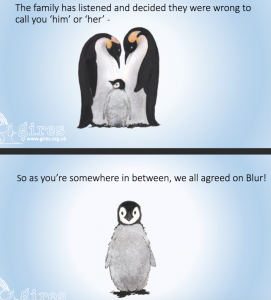
Blur – the non-binary kindergarten penguin for 3-6 year olds.
UK-based GIRES (Gender Identity Research & Education Society) enrapture 3-6 year olds with their magical gender-selecting cartoon penguin stories designed to brainwash teach gender identity to impressionable children.
In their lesson plans for teachers they stress that “Understanding gender diversity should start at primary school level, before children’s views become influenced by the prejudices of the adults around them.”
In this story the penguin’s parents ‘didn’t immediately understand’ and were wrong to think it was a boy or a girl. In fact, it is neither. A party is thrown to celebrate its non-binary status.
Idiot parents watch in the background.

In another tale those silly old parents tell Polly they can’t tell if she’s a boy or a girl so whenever she’s ready she should tell them herself. She tells a friend instead, that she’s a boy. Humbled and re-educated parents and celebratory parties abound.
This is magical thinking at its most spendid.
Under the new draft guidelines created by Education Scotland, NHS boards and the Scottish Government, from 2019, children will be told in the classroom “Your gender is what you decide. You might be a boy or a girl.”
There is an informative Twitter thread about the details and implications of this, here.

Rather than trying to explain the incredible complexity and long term implications of transition, every attempt is made to make it appear something simple, straightforward and special. Penguins! Parties! All your problems solved! Why so simple? Because children cannot understand the implications. And if they cannot understand the implications, they cannot consent.
Why are hundreds of thousands of pounds being given in grants to the organisations that promote this ideology? Why not spend that money on a ‘girls can play football, boys can like tutus‘ campaign?
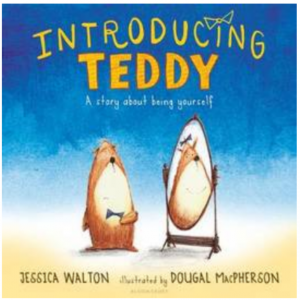 The precious bear in Introducing Teddy makes it sound so simple when he confides,“In my heart, I’ve always known that I’m a girl Teddy, not a boy Teddy.”
The precious bear in Introducing Teddy makes it sound so simple when he confides,“In my heart, I’ve always known that I’m a girl Teddy, not a boy Teddy.”
In ‘George‘ a story about a boy who wants to play a female part in a play, transition is presented as a rolicking good adventure:
“Everyone thinks George is a boy, but she knows better… George and her friend come up with a plan so she can finally be who she wants to be.”
Lashings of post-op ginger beer all round, then.
“Don’t call me he, don’t call me she, please don’t assume who I must be,” waxes the eloquent Phyllis Wrothblatt in ‘All I Want to be is Me’. Despite having been scribed by a middle-aged MTF, the book is described as giving “voice to the feelings of children who don’t fit into narrow gender stereotypes, and who just want to be free to be themselves.”
Er, hang on… stop right there. That would be ALL children, wouldn’t it? No child is a stereotype. ALL children want to be free to be themselves!
A friend of mine had a sign hanging in her kitchen when our kids were little, which read “You are clever, beautiful, talented and special – just like everyone else.”
Let’s keep that in mind shall we, while we’re setting the cloth out on the altar of the gender fairy? Transition is being presented to kids as simple, fun, an adventure. A viable option for any child who doesn’t see themselves as a stereotype. It isn’t like that.
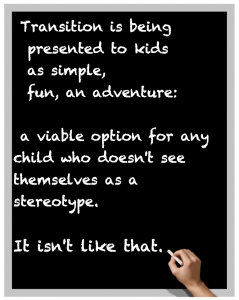 When very, very young, both Jazz Jennings and Jackie Green told their parents that ‘God had made a mistake and I should have been a girl.’ Both children were told that an operation to make them into a girl would be possible when they were grown up.
When very, very young, both Jazz Jennings and Jackie Green told their parents that ‘God had made a mistake and I should have been a girl.’ Both children were told that an operation to make them into a girl would be possible when they were grown up.
One mother of a trans-identified five year old says of her daughter, “He talks about ‘when I start having medicine to make me grow a willy.’”
Some might wonder how a five year old thought that such magical medicine existed. Of course, it doesn’t. A girl can’t ‘grow a willy’. Nothing can actually turn a boy into a girl, certainly not in the way that a six year old could conceive it, apart from magical thinking.
Jackie Green underwent vaginoplasty on his sixteenth birthday.
“Everyone says what is in between your legs doesn’t matter and I agree,” says Jennings, who underwent the same operation earlier this year, age seventeen.
I was going to link to some information and photographs about what ‘MTF’ vaginoplasty entails, but if you really want to see, you can use your Google-Fu.
The ‘gender non-conforming’ child often grows into a gay adult.
LGBT is so often referred to in one breath, as if the letters are all sides of the same dice, that it becomes hard to separate them. Gender critical people, who question the ethics of transitioning children, are often accused of being ‘anti LGBT’. On the contrary, many of us are aware that more often than not, it is potentially gay kids who are harmed by child transition.
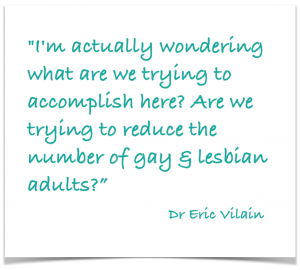 Traditionally, ‘gender non-conforming’ kids often turn out to be gay if left alone to grow up and find their own space. But if a child who is likely to grow up to be homosexual misses out on a timely puberty, how is he supposed to have the experiences that would have naturally enabled that sense of identity to form?
Traditionally, ‘gender non-conforming’ kids often turn out to be gay if left alone to grow up and find their own space. But if a child who is likely to grow up to be homosexual misses out on a timely puberty, how is he supposed to have the experiences that would have naturally enabled that sense of identity to form?
The GIRES penguins demand parties and celebration; those special bathroom rules were made just for you: that interview in the paper where mummy was so proud to see your photo: who would actually want to be a stompy old lesbian when they could be a fortitudinous transboy? Who would want to be an effeminate gay boy when they could be a precious transgirl?
Although many gay people say they knew they were gay from a young age, many others don’t come to the realisation until their 20s or older. The lesbian girl may feel different but she may not yet know why. She may assume these feelings mean she should be a boy, especially if people have come into her school and told her that is a distinct possibility. Puberty has not struck and those feelings may not be fully formed. She feels like an outsider and transition seems like an answer: it ostensibly offers a way to belong, to conform. But of course, it doesn’t. Puberty helps us on the road to establishing who we are and is an essential – the essential- step on the road to adulthood.
The name and pronoun change consolidates this idea. The puberty blockers stop the puberty that might have resolved her issues. The block is both physical and psychological and the child is further alienated from her peers.
Koerte, Geocker et al discussed this in Dtsch Arztebl Int , in 2008.
“Multiple longitudinal studies provide evidence that gender-atypical behavior in childhood often leads to a homosexual orientation in adulthood, but only in 2.5% to 20% of cases to a persistent gender identity disorder.”
They conclude that “irreversible physical interventions are clearly not indicated until after the individual’s psychosexual development is complete.” The idea that the effects of puberty-blocking treatment are totally reversible is true, they believe,“only with respect to its physical effects, not with respect to the irreversible damage it does to the process of psychosexual development.”
“I’m actually wondering what are we trying to accomplish here?” asks Dr Eric Vilain, chief of Medical Genetics at UCLA, a pediatrician and geneticist, in a video interview. “Are we trying to reduce the number of gay & lesbian adults?”
How can a child understand the implications of puberty blockers?
In 2015, Polly Carmichael of the Tavistock told the Guardian about “simplistic arguments that if you have the blocker then all the problems disappear. In our experience, all the problems do not go away.” She adds, “The blocker is said to be completely reversible, which is disingenuous because nothing’s completely reversible.”
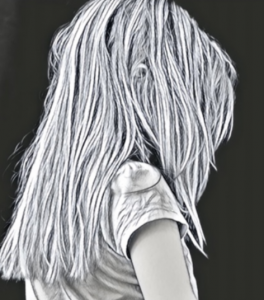 The use of puberty blockers to treat trans-identified (transgender) children has only been around for a decade, pioneered by Boston Children’s Hospital as recently as 2007. By 2017, over 800 young people in the UK had been prescribed puberty blockers. These drugs block the sex hormones oestrogen and testosterone. They stop the onset of periods and breast growth, or voice-deepening and facial hair growth. The drugs have been tested for use in halting precocious puberty, although there have been concerns about side effects of Lupron, with reports of spinal problems, osteoperosis and fibromalgia. Depression and anxiety have also been reported by women who had been prescribed the drug as children. In America, more than 10,000 ‘adverse event’ reports have been filed with the FDA (Federal Drug Agency) , reflecting the experiences of women who’ve taken Lupron.
The use of puberty blockers to treat trans-identified (transgender) children has only been around for a decade, pioneered by Boston Children’s Hospital as recently as 2007. By 2017, over 800 young people in the UK had been prescribed puberty blockers. These drugs block the sex hormones oestrogen and testosterone. They stop the onset of periods and breast growth, or voice-deepening and facial hair growth. The drugs have been tested for use in halting precocious puberty, although there have been concerns about side effects of Lupron, with reports of spinal problems, osteoperosis and fibromalgia. Depression and anxiety have also been reported by women who had been prescribed the drug as children. In America, more than 10,000 ‘adverse event’ reports have been filed with the FDA (Federal Drug Agency) , reflecting the experiences of women who’ve taken Lupron.
“The biggest problem though is that studies show that 100% of kids who go on puberty blockers do not desire to come off. They go on to cross sectional hormones where they remain infertile. Also sexual pleasure development does not occur from early pubertal blockade… These kids will become permanently damaged adults. Add in the increased cardiovascular, thromboembolic and cancer risks and you have a recipe for disaster.”
Used to delay puberty, ostensibly to ‘buy time’ for the trans-identified child to make its mind up about transition, puberty blockers can make medical transition easier by suppressing secondary sex characteristics and leaving the child’s body more of an androgynous medical ‘tabula rasa’. Growth spurts in height do not occur, reproductive organs do not develop and muscle mass is not gained. How exactly this is ‘reversible’ as it isn’t possible to turn back time, is debatable. Where the use of puberty blockers leaves the majority of children who would traditionally change their minds is a question which does not seem to be being asked.
“We have shifted to make the treatment available earlier and earlier. But the earlier you do it, the more you run the risk that it’s an intervention people would say yes to at a young age, but perhaps would not be so happy with when they move into their later adulthood.”
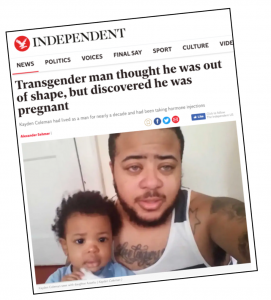 While we occasionally read in the press about transmen who have babies, most doctors recommend a hysterectomy after 5 years on Testosterone because the effects can create similar effects to polycystic ovarian syndrome (PCOS) which has been linked to increased risk of endometrial and ovarian cancer. To state the obvious, a hysterectomy results in a sterile young woman.
While we occasionally read in the press about transmen who have babies, most doctors recommend a hysterectomy after 5 years on Testosterone because the effects can create similar effects to polycystic ovarian syndrome (PCOS) which has been linked to increased risk of endometrial and ovarian cancer. To state the obvious, a hysterectomy results in a sterile young woman.
The puberty blockers and hormone treatments that are becoming more commonplace arrest both the physical and psychological development of a child.
“Young people with gender dysphoria constitute a singularly vulnerable population, one that experiences high rates of depression, self-harm, and even suicide. Moreover, children are not fully capable of understanding what it means to be a man or a woman.”
The child put on puberty blockers does not go through puberty with their peers, their ‘difference’ is further accentuated and that lost experience cannot be regained. Puberty suppression has a significant negative effect on the height growth rates of both males & females, and can result in problems with bone-mineral density. Changing the normal physical development of a child in an attempt to treat a psychological condition is a serious step, and many would question the idea that it would result in a more accurate diagnosis of the child’s underlying problems.
“Whether puberty suppression is safe and effective when used for gender dysphoria remains unclear and unsupported by rigorous scientific evidence.”
These are complex ideas which can be difficult for the adult mind to explore and consider. How a child is supposed to work through these issues is a question that should be explored more deeply, rather than being brushed under the carpet.
“Experimental medical treatments for children must be subject to especially intense scrutiny, since children cannot provide legal consent to medical treatment of any kind (parents or guardians must consent for their child to receive treatment), to say nothing of consenting to become research subjects for testing an unproven therapy.”
Ten years after the first pioneering treatments of 2007, we now hear of cases where hormones are prescribed to children without the parents’ support or consent. In one case (in Canada) the prescribing physician actually refused to meet with the parents of the child before prescribing testosterone. A UK doctor who was privately prescribing hormones to children as young as twelve was recently suspended pending investigation by the General Medical Council, but is now practicing again.
Research from Bechard, Zucker et al states, “It has been our clinical impression that the psychological vulnerability of at least some of these youth has been overlooked.”

About 17% of all children suffer from a mental disorder in early childhood, defined as the period up to the age of 6 years. In their 2008 study, published in Deutches Artzeblatt, Korte, Geoker et al made two important observations about Gender Identity Disorder (GID) in children.
“GID (gender identity disorders) are often associated with emotional and behavioral problems as well as a high rate of psychiatric comorbidity.
Neurobiological genetic research has not yet convincingly shown any predominant role for genetic or hormonal factors in the etiology of GID.”
In other words, firstly, GID is a problem of the mind, often co-existing with other problems of the mind, and secondly, there seems to be no physical cause for it. If a young person feels that they are something they are not, the problem is with the mind, not the body.
Of the twenty one 5-17 year olds who received a new diagnosis of GID in Vikram Jaswal’s clinic (up to mid-2008), all had psychopathological abnormalities that, in many cases, led to the diagnosis of additional psychiatric disorders.
It seems hard to believe that trans-identified children can fully understand the implications of transition and consent to such procedures. Not just the psychological implications of being told that they are something they are not and the effects of delayed puberty, but the physical effects of hormonal medications and intrusive surgeries.
A life with a micro-penis, or no penis, impaired sexual feeling and function, embarking on a medical pathway which will almost certainly result in sterility- how can a child consent to this?
Kids believe what grown ups tell them.
“Children have developed a specific bias to believe what they’re told,” says Jaswal, of his 2010 study of 3 year olds, published in Psychological Science. “It’s sort of a short cut to keep them from having to evaluate what people say.”
 Dr Vilain believes early social transitions unfairly push children to thinking they should identify as the opposite sex and that social transition can lead to unnecessary medical interventions for transgender kids.
Dr Vilain believes early social transitions unfairly push children to thinking they should identify as the opposite sex and that social transition can lead to unnecessary medical interventions for transgender kids.
“I think it’s putting a lot on the shoulders of these children,” said Vilain, in 2017. “It’s putting them on a path that will have a lot of medical and surgical consequences.”
He goes on to say that it will be “much, much harder for them (trans-identified children) to get out of this belief,” if everyone around them has affirmed their trans identity from an early age.
It’s very important to keep in mind that according to numerous studies – and the Tavistock Clinic itself – traditionally, most trans-identified kids desist.
Being told your feelings are valid is not the same as being told they’re true. And that’s the fine line that is more and more frequently being crossed in the treatment of children who sufferer from gender dysphoria in all its forms.
That’s the fundamental premise behind the transgender child. It isn’t about breaking down stereotypes and freeing the spirit, it is about those good old-fashioned, sexist, pink and blue boxes and selling the illusion of how elementary and desirable it might be to skip between the two.
Adult expectations
It is also significant to consider what sociologists call ‘labelling’, close neighbour of the Pygmalion effect. As social psychologist Robert Rosenthal puts it, “what one person expects of another can come to serve as a self-fulfilling prophecy.”
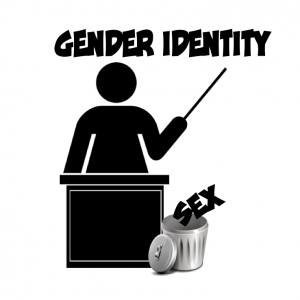 If a parent has fiercely and publicly fought, for example, for their child’s access to a different bathroom or a change of pronouns at school, and insisted to all around that their child was ‘born that way’ it will be especially hard for the child to step back and say they’ve changed their mind, or they were confused, or they no longer feel that way. If a school has changed pronouns for a child, or had a special assembly, the child may feel embarrassed or insecure about desisting. To renounce being trans and the special status that accompanies it, both consciously and subconsciously, will be much harder if the child feels they are contradicting or even letting down those that have supported them.
If a parent has fiercely and publicly fought, for example, for their child’s access to a different bathroom or a change of pronouns at school, and insisted to all around that their child was ‘born that way’ it will be especially hard for the child to step back and say they’ve changed their mind, or they were confused, or they no longer feel that way. If a school has changed pronouns for a child, or had a special assembly, the child may feel embarrassed or insecure about desisting. To renounce being trans and the special status that accompanies it, both consciously and subconsciously, will be much harder if the child feels they are contradicting or even letting down those that have supported them.
If the girl’s parents or teachers have told her yes, she’s a boy if she says so, and she then decides she is not, the child may feel she is calling them liars if she openly changes her mind. And remember – until recently more than one study showed that up to 80% of kids desisted.
“If a lot has been invested in living in a gender role, then, potentially, it is difficult for young people to say: ‘Well, actually I don’t feel like that any more.’” says Polly Carmichael of the Tavistock Clinic.
There are also some parents for whom the brave transgender child is a validation of their own expectations and values. Some parents may prefer a trans child to a gay one if their religion condemns homosexuality. One mother boasted that now her boychild had transitioned to a girl, she (sic) would be able to get married in their local church. In a facebook group, a parent whose child shows no inclination to take puberty blockers looks for ways to persuade them to do so. Another parent reports on her blog how her pre-teen, non-binary child cried and didn’t want her first injection, but “after some panic and more than a few tears” was persuaded otherwise.
Recently a seven-year-old boy was removed from his mother and placed in paternal custody because the judge ruled the mother had caused the boy “significant emotional harm (by pressing him) into a gender identification that had far more to do with his mother’s needs and little, if anything, to do with his own”. The mother was also told by the judge to stay away from the controversial transgender children’s charity, Mermaids.
In extreme cases, Munchausens by proxy, an illness where a parent or carer causes or excabates symptoms of illness in a child, cannot be ruled out.
“I was told that my transgender feelings were permanent, immutable, physically deep-seated in my brain and could NEVER change, and that the only way I would ever find peace was to become female.” writes one man of his childhood.
The Transgender Child may very well come to believe that all their value is tied up in their transgender identity. How to back down without feeling you’ve betrayed those closest to you, who have fought for you to be your ‘authentic self’?
Understanding consequences
 Transition is not simple. While younger children can simply grow or cut their hair and change their clothes in order to ‘pass’ as a girl or a boy, there will always be awkward situations requiring a high level of cognitive dissonance or practical concerns around masquerading as the opposite sex. But the boy has been told he can become a girl, and why would he not believe that? As of next year in Scotland eight year olds will be taught in the classroom that ‘some trans people change their bodies‘. The boy will know that is something that he might want to do someday so he looks just like a real girl. But ‘one day’ is a very long time away when you’re eight and the summer holidays last forever.
Transition is not simple. While younger children can simply grow or cut their hair and change their clothes in order to ‘pass’ as a girl or a boy, there will always be awkward situations requiring a high level of cognitive dissonance or practical concerns around masquerading as the opposite sex. But the boy has been told he can become a girl, and why would he not believe that? As of next year in Scotland eight year olds will be taught in the classroom that ‘some trans people change their bodies‘. The boy will know that is something that he might want to do someday so he looks just like a real girl. But ‘one day’ is a very long time away when you’re eight and the summer holidays last forever.
Then puberty strikes.
If the boy doesn’t want his voice to break, his Adam’s apple to develop and hair to start growing on his face; if the girl doesn’t want breasts and curvy hips to begin to show, if the outward trappings are to be maintained, then puberty blockers will be needed. At this point it may well seem like a natural progression to the child whose ‘gender identity’ has been affirmed. After all, if the girl has had it confirmed that yes, she is actually a boy, it may seem like an inevitable next step.
 Can either even begin to comprehend the restrictions and consequences of being a lifelong medical patient? Of course they can’t. This is refected in UK law- which doesn’t even hold an eleven year old to be empathic enough to look after a pet properly.
Can either even begin to comprehend the restrictions and consequences of being a lifelong medical patient? Of course they can’t. This is refected in UK law- which doesn’t even hold an eleven year old to be empathic enough to look after a pet properly.
How old is ‘grown up’?
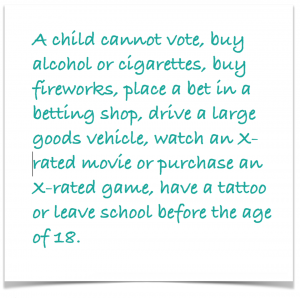
There are a variety of things that a child can do independently by law in England and Wales. A child can buy a pet unaccompanied age 12 and take up part-time work at 13. Age 14 a child is considered to be old enough to be held responsible for their own seatbelt, and can give evidence under oath. A sixteen year old can get married or serve in the armed forces with parental permission. They can also ride a moped, play the National Lottery and consent to sex, although probably not all at the same time.
At seventeen a child can become a blood donor, and take a driving test.
A child cannot vote, buy alcohol or cigarettes, buy fireworks, place a bet in a betting shop, drive a large goods vehicle, watch an X rated movie or purchase an X rated game, have a tattoo or leave school before the age of 18.
At eighteen, we act as if a magical button is pressed and maturity is ingested along with the birthday cake.
The fastest growing group of trans-identified children is teenage girls. In fact, ROGD, or Rapid onset Gender Dysphoria, was described in The Lancet in 2017.
“Gender incongruence can also emerge for the first time during pubertal development, with no history of gender-discordant behaviours or feelings reported in childhood or prepubertal adolescence.”
Psychotherapist Lisa Marchiano notes:
“In the past five or so years, gender dysphoria has begun presenting in a new way. Adolescents… are identifying as trans ‘out of the blue’ without any childhood history of discomfort with their sex…”
The NHS website has this to say about hormone treatments.
“Teenagers who are 17 years of age or older may be seen in an adult gender clinic. They are entitled to consent to their own treatment and follow the standard adult protocols… By this age, doctors can be much more confident in making a diagnosis of gender dysphoria and, if desired, steps can be taken towards more permanent hormone or surgical treatments to alter your child’s body further, to fit with their gender identity.”
As many studies show, however, our brains aren’t fully developed before the age of twenty five.
“We now realise that the brain doesn’t stop developing until mid-20s or even early 30s.” says Sarah Helps, consultant clinical psychologist. “This is particularly important in terms of social reasoning, planning, problem solving and understanding. So the brain is reorganising itself, which then means that different thinking strategies are used as your brain becomes more like an adult brain.”
in 2013, new guidance for psychologists acknowledged that adolescence effectively runs up until the age of 25 for the purposes of treating young people. Neuroscience shows that a young person’s cognitive development continues well into their 20s and that emotional maturity, self-image and judgement will be affected until the prefrontal cortex.
“The idea that suddenly at 18 you’re an adult just doesn’t quite ring true,” says child psychologist Laverne Antrobus, who works at London’s Tavistock Clinic. “My experience of young people is that they still need quite a considerable amount of support and help beyond that age.”
In reality, there are procedures that doctors are unlikely to recommend in certain circumstances. In my early 20s I told my doctor I didn’t want children and wished to be sterilised. He refused to consider it, which I found extremely pedantic and bombastic of him at the time. Fast forward less than a decade and I was pregnant and looking forward to being a mother. Did he have the right to deny me that procedure? Maybe, maybe not. One thing is for sure, I was well over the age of legal consent.
Consent is complex, and there is no clear cut line as to when our brains reach maturity.
Informed Consent
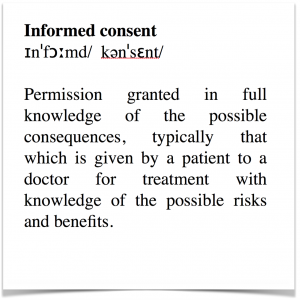 Many surgeons in the USA are happy to operate on children despite the minimum age in the USA standing at eighteen and the legal impossibility of gaining informed consent.
Many surgeons in the USA are happy to operate on children despite the minimum age in the USA standing at eighteen and the legal impossibility of gaining informed consent.
Dana Beyer, a father and Executive Director of Gender Rights Maryland , advocates that children should have a full right to self determination, claiming:
“If a child grows up and decides to de-transition, then what of it? The harm done is minimal.”
A six year old, told that he can ‘become’ a girl, a nine year old whose school changes their pronouns, an eleven year old told that puberty blockers will ‘buy her time’… how can they understand the implications of this adult-sanctioned change? The little boy who wants to get rid of his willy – can he understand the implications of crafting a neo-vagina, crafted from the remains of his scrotal sac or intestines, that will need dilating for the rest of his life? The little girl who doesn’t want periods or breasts – can she understand the significance of growing facial hair that will never recede, of the medically-recommended hysterectomy ; of the promised penis that will need to be forged from the flesh of her arm or her thigh?
Every day that a girl is told she’s a boy, the idea is affirmed that she is something she is not, and each day is a further step down the transition path. How can a child consent to procedures that will leave them unable to experience a normal puberty, when they are too young to understand what puberty is? How can they begin to understand the implications of a future as a life-long medical patient; the side effects of hormone treatments, sterility, loss of sexual function and the potential problems involved with surgery? My belief is that they can’t.
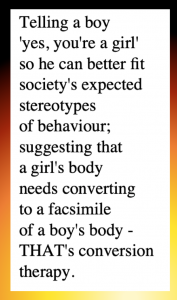 The idea that children cannot consent has not evolved to restrict them, but rather to protect them. Is it such a huge stretch of thinking to suggest that a child who can consent to medical transition can also consent to other things? Consuming alcohol? Taking drugs? Sexual intercourse? If not, why not? These waters are very muddy indeed.
The idea that children cannot consent has not evolved to restrict them, but rather to protect them. Is it such a huge stretch of thinking to suggest that a child who can consent to medical transition can also consent to other things? Consuming alcohol? Taking drugs? Sexual intercourse? If not, why not? These waters are very muddy indeed.
Activists claim that trying to help kids feel happier in their bodies is conversion therapy, but this is a myth. Telling a boy ‘yes, you’re a girl’ so he can better fit society’s expected stereotypes of behaviour; suggesting that a girl’s body needs converting to a facsimile of a boy’s body – THAT’s conversion therapy.
Why are hundreds of thousands of pounds being given in grants to the organisations that promote this ideology? Why not spend that money on campaigns to break down gender sterotypes?
Gender is a social construct, a set of sexist and outdated stereotypes forced onto males and females by society. Most of us don’t even have a ‘gender identity’ and it is regressive to suggest to kids that they do. Personalities come in all types and both boys and girls should be allowed to play with a variety of toys independent of what they have between their legs. The ‘gender revolution’ is very far from a revolution if it can’t deal with concepts as simple as this.
Children can’t consent to transition because they can’t understand what it means to be a man or a woman. They have no grasp of the complexities of adult life in the ‘big wide world’, or of the effect transition may have on their future physical relationships and sexual feelings. They can’t understand – nor should they be expected to – the physical complexities of medical transition.
The idea that a child can consent to transition? It’s a myth.


Amazingly comprehensive. Thank you for this. I will be bookmarking as resource.
Wonderful essay, Lily! Well done, as usual!
Pingback: Right of reply – Kay Green
Excellent.
This is very comprehensive, but there is one area you haven’t dealt with, and I would like to see you do the research and write about it. (better you than me 😉 It’s the dissociative experience that will result when a child is told they are not their body. It will cause them to “split”. Children are still learning to ground themselves in their body — it’s essential that they be able to do that. If anything, children need to be taught meditation, which will help them settle into their bodies/emotions and feelings. Instead children are being taught they are something (what?) in a body. How are they supposed to centre themselves, and ground themselves? They will be a consciousness uprooted from the body, and quite possibly feeling trapped by a body, any body. Dissociation is terribly debilitating, and it is a result of abuse. Check out people with Dissociative Identity Disorder (multiple personality disorder). They contain multitudes of different “identities” of both sexes, different ages and even non-human.